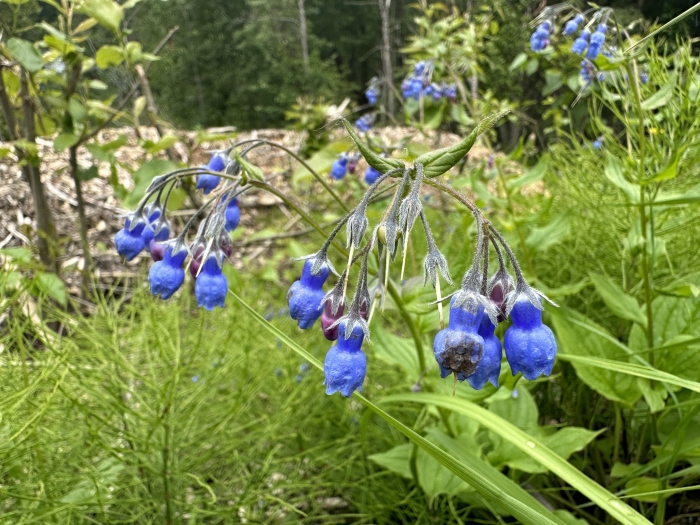Tall Lungwort
(Mertensia paniculata)
Tall Lungwort (Mertensia paniculata)
/
/

Jason Grant
CC BY 4.0
Image By:
Jason Grant
Recorded By:
Copyright:
CC BY 4.0
Copyright Notice:
Photo by: Jason Grant | License Type: CC BY 4.0 | License URL: http://creativecommons.org/licenses/by/4.0/ | Rights Holder: Jason Grant | Publisher: iNaturalist | Date Created: 2023-07-11T14:25:58-07:00 |




















Estimated Native Range
Summary
Mertensia paniculata, commonly known as Tall Lungwort, Tall Bluebells, or Northern Bluebells, is a shade-tolerant perennial herb native to moist meadows, streambanks, and open forests in northwestern North America, including the Great Lakes region. It typically grows to a height of 0 to 2 feet and can spread to form clumps. The plant is characterized by its clusters of nodding, bright-blue, bell-shaped flowers that bloom from late spring to early autumn, adding a splash of color to shaded garden areas. The foliage is lance-shaped and can turn a reddish color in the fall, providing additional ornamental interest.
Tall Lungwort is valued for its ease of maintenance and ability to thrive in part shade to full shade conditions, making it an excellent choice for woodland gardens, shaded borders, and naturalized areas. It prefers moist, well-drained soils rich in organic matter. While it is generally disease-resistant, it can be susceptible to root rot if planted in overly wet conditions. In cultivation, it is not known to be invasive and does not have aggressive roots, making it a safe choice for most garden settings. The dried leaves of Tall Bluebells have been traditionally used to make herbal tea reputed to stimulate the respiratory system.CC BY-SA 4.0
Tall Lungwort is valued for its ease of maintenance and ability to thrive in part shade to full shade conditions, making it an excellent choice for woodland gardens, shaded borders, and naturalized areas. It prefers moist, well-drained soils rich in organic matter. While it is generally disease-resistant, it can be susceptible to root rot if planted in overly wet conditions. In cultivation, it is not known to be invasive and does not have aggressive roots, making it a safe choice for most garden settings. The dried leaves of Tall Bluebells have been traditionally used to make herbal tea reputed to stimulate the respiratory system.CC BY-SA 4.0
Plant Description
- Plant Type: Shrub, Herb
- Height: 1.5-2.5 feet
- Width: 1.5-2 feet
- Growth Rate: Moderate
- Flower Color: Blue
- Flowering Season: Spring, Summer
- Leaf Retention: Deciduous
Growth Requirements
- Sun: Full Sun, Part Shade, Full Shade
- Water: Medium, High
- Drainage: Medium, Slow
Common Uses
Butterfly Garden, Low Maintenance, Showy Flowers, Water Garden
Natural Habitat
Moist meadows, streambanks, and open forests in northwestern North America, including the Great Lakes region
Other Names
Common Names: Arctic Bluebells, Panicled Bluebells, Panicled Lungwort, Tall Lungwort, Northern Bluebells
Scientific Names: , Mertensia paniculata, Casselia paniculata, Cerinthodes longistylum, Cerinthodes paniculatum, Lithospermum corymbosum, Lithospermum paniculatum, Lithospermum schreberianum, Mertensia corymbosa, Mertensia leptophylla
GBIF Accepted Name: